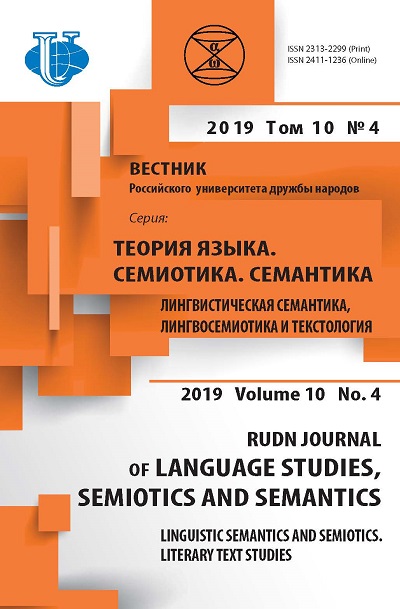Non-Derivative and Derivative Homonyms in the Russian and Uzbek Languages
- Authors: Kurbanov B.S.1
-
Affiliations:
- Uzbek State University of World Languages
- Issue: Vol 10, No 4 (2019): Linguistic Semantics and Semiotics. Literary Text Studies
- Pages: 906-919
- Section: FUNCTIONAL SEMANTICS
- URL: https://journals.rudn.ru/semiotics-semantics/article/view/22776
- DOI: https://doi.org/10.22363/2313-2299-2019-10-4-906-919
- ID: 22776
Cite item
Full Text
Abstract
The article discusses questions regarding non-derivative and derivative homonyms by the example of verbs of the Russian and Uzbek languages. In sight are the problems of distinguishing polysemy and homonymy, the criteria for determining their boundaries. The basis of the study is the study of the internal structure of the word. The classification of non-derivative and derivative verbs-homonyms of the Russian and Uzbek languages is presented taking into account the ways of their formation, derivative and non-derivative lexemes depending on the place in the word-building nest. Examples of word-formation types, in particular, affix word-formation methods inherent in the formation of verbal homonyms in the comparable Russian and Uzbek languages are given. The article also deals with the features and distinctive properties of lexical, derivational homonyms, examples of reflected homonymy in the system of derivational nests are given. Word-building nests are considered as the main criterion for determining the production and non-production of verbal homonyms of the Russian and Uzbek languages. The classification of non-derivative and derivative homonyms of the Russian and Uzbek languages is developed. Examples of compiling word-formation nests of verbs in the Uzbek language are given, taking into account the possibility of the formation of the largest number of derivatives in the structure of nests. Consequently, fragments are shown regarding the organization of reflected homonymy in both Russian and Uzbek languages. The analysis results indicate that the phenomenon of homonymy in the Russian and Uzbek languages has regular and systemic character. The regularity of relationships and interactions of lexical paradigms of comparable languages in the formation of derivatives, in particular, reflected homonyms, is argued. An important place in this is given to homonymy, arising due to the homonymy of foundations and affixes.
About the authors
Bakhram Sh. Kurbanov
Uzbek State University of World Languages
Author for correspondence.
Email: kurbanov.baxram@bk.ru
PhD student
Malaya koltsevaya str., G-9a quarter, 21a, Chilanzar massif, Uchtepa district, Tashkent, Uzbekistan, 100138References
- Xasanov, E.R. (2016). Factors determining the development of polysemy. Russian language and literature in Uzbekistan — 2016 In Materials of the Republican scientific-practical conference dedicated to the 125th anniversary of the birth of M. A. Bulgakov. Tashkent: National University of Uzbekistan. pp. 133—134. (In Russ.).
- Novikov, L.A. (1982). Semantics of the Russian language. Moscow. (In Russ.).
- Golovnya, A.I. (1974). Homonymy as a systemic category of language. Minsk: Belarusian State University. (In Russ.).
- Pardaev, A.S. & Kurbanov, B.Sh. (2015). Typology of homonyms and homonymic word-building nests in the Russian language In Actual problems of Russian word-formation. Samarkand: Samarkand State University. pp. 64—68. (In Russ.).
- Rubleva, O.L. (2004). Lexicology of the modern Russian language. Vladivostok: Publishing house of DVGU. (In Russ.).
- Pardaev, A.S. & Kodirova, Z.A. (2016). Word-building nests as a criteria for distinguishing non-derivative homonyms in the Russian language In Actual problems of Russian word-formation. Materials of a traditional republican seminar in the framework of the Uzbek scientific school of Russian word formation. Tashkent: National University of Uzbekistan. pp. 68—72. (In Russ.).
- Akhmanova, O.S. (1957). Essays on General and Russian Lexicology. Moscow: Publishing house of Uchpedgiz. (In Russ.).
- Mirzaeva, Sh.R. & Usmanova, S.Yu. (2016). Homonyms of Russian language in the frequency aspect. Russian language and literature in Uzbekistan, 2016 In Materials of the Republican scientific-practical conference dedicated to the 125th anniversary of the birth of M.A. Bulgakov. Tashkent: National University of Uzbekistan. pp. 68—71. (In Russ.).
- Tixonov, A.N. & Pardaev, A.S. (1989). The role of nests of root words in the systemic organization of Russian vocabulary. Reflected synonymy. Reflected homonymy. Reflected Anthony. Tashkent: Publ. Fan. (In Russ.).
- Vinogradov, V.V. (1968). Problems of the morphemic structure of the word and the phenomenon of homonymy in Slavic languages In Slavic linguistics. 6th international congress of Slavists. Moscow: Nauka. pp. 53—119. (In Russ.).
- Ataeva, R.R. (2019). The Structural Peculiarity of the Russian Vertex Derivational Nestsof Asymmetrical Type. Bulletin of Chelyabinsk State University, Philology Sciences, 6 (428), Iss. 117, 23—31. (In Russ.). doi: 10.24411/1994-2796-2019-10603. (In Russ.).
- Tursunov, U., Muxtorov A. & Raxmatullaev, Sh. (1992). Modern Uzbek literary language. Tashkent: Uzbekistan. (In Uzb.).
- Tixonov, A.N. (1985). Word formation dictionary of Russian language. Moscow: Russkij yazyk. (In Russ.).
- Axmanova, O.S. (1974). Dictionary of homonyms of the Russian language. Moscow: Russkij yazyk. (In Russ.).
- Raxmatullaev, Sh. (1984). Explanatory dictionary of homonyms of the Uzbek language. Tashkent: Oqituvchi. (In Uzb.).
- Mengliyev, B., Bahriddinova, B., Xoliyorov, O’., Zaripova, M. & Xushvaqtov, M. (2008). Word-formation dictionary of the Uzbek language. Tashkent: Publ. Yangi asr avlodi. (In Uzb.).
Supplementary files












